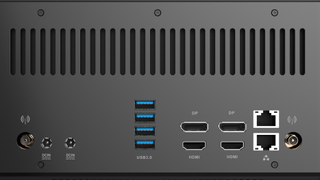TechRadar Verdict
Want a high-end gaming system that doesn’t need to live on the floor? The Zotac Magnus EN1080 offers the very best levels of performance if you can stomach the high initial cost and additional expenditure needed to make it operational.
Pros
- +
Elegant design
- +
Almost silent
- +
Fantastic GPU performance
Cons
- -
Limited upgrade options
- -
Very expensive for a barebones unit
- -
Large for a small form factor system
Why you can trust TechRadar
Here is the Zotac Magnus EN1080 configuration sent to TechRadar for review:
CPU: Intel Skylake Core i7-6700 (quad-core 3.4 GHz, up to 4.0 GHz, 8MB Cache)
Graphics: Nvidia GeForce GTX 1080 (8GB GDDR5X)
RAM: Not included, accepts 2 x DDR4-2133/1866 SODIMM slot (up to 32GB)
Motherboard: Custom design
Power Supply: 2x AC Adapter (DC 19.5V/180W)
Storage: Not included, accepts 1 x M.2 PCIE NMVe, 1 x 2.5-inch SATA III HDD/SSD
Ports: 4 x USB 3.0, 1 x USB 3.1 Type-A, 1 USB 3.1 Type-C, 1x microphone jack, 1x headphone jack, 2 x DisplayPort 1.3, 3 x HDMI 2.0, SD card reader
Connectivity: 802.11ac; Dual Gigabit Ethernet ports; Bluetooth 4.0
Operating system: Not included
Weight: Varies by components used
Size: 7.99 x 8.86 x 5.03 inches (W x D x H)
Building small systems can so often be a compromise. With no slots, limited storage devices or space for exotic cooling technology there are practical limits to how powerful a system can be made inside a SFF (Small Form Factor) enclosure.
That’s the conventional logic confronted by Zotac’s Magnus EN1080 10 Year Anniversary Edition Barebones (ZBOX-EN1080K-BE).
As a celebration of the Zotac company and brand, the Magnus EN1080 is also a showcase for the engineering and design on which the company has built a formidable reputation.
This SFF system might be more Shuttle PC-sized than typically Mini-PC, but it’s still amazingly small for a typical gaming machine, unless it’s one that's had an unfortunate encounter with a car crusher.
Before marvelling at what’s crammed inside, let’s first admire the façade.
Simple by design
Zotac adores minimalist aesthetics, and the Magnus EN1080 waves that banner with a highly finished but almost feature-free case exterior.
The corners are all chamfered, the top uses Zotac’s trademark honeycomb grill, and the parts all go together in a highly engineered and precise way.
The front is characterised by the card slots and ports that you’d normally expect there, and predictably the back has an expanded port selection.
On the fascia are headphone and mic, 3-in-1 card reader (SD/SDHC/SDXC), a single HDMI and two USB 3.1 ports. One of these is Type-C and the other is of the traditional Type-A variety.
At the rear are four USB 3.0 Type-A ports, dual 10/100/1000 LAN ports, dual power inputs and dual WiFi antenna connectors.

There is also space on the back for two additional HDMI 2.0 and two DisplayPort 1.4 ports, bringing it the total to five video outputs. Four can be active at once if you fancy multiscreen gaming.
An obvious complaint might be that it doesn’t include a Thunderbolt port. And, for those wanting to use an EN1080 for editing 4K video that’s a valid point. Also, the lack of an optical audio S/PDIF might irk those craving an ultimate media system.
Those omissions hint that the underlying concept of the EN1080 has a flaw; being excessively gamer focused when a system this compact and powerful could easily achieve a much wider appeal.

Another minor criticism is that the shades-of-black motif is excessively understated, or it is until you fire up the system.
Zotac built a lighting system branded SPECTRA into the case that’s software customisable through a provided Windows app. There are only three points of illumination and they're not especially bright as case illumination goes.

You can set the color and various effects on them individually, should that prospect excite you.
While programmable lighting is fun, it seems at best a mild distraction from the real spectacle going on under the skin. An ensemble of hardware so impressive that it puts most desktop gaming systems in the shade.
- Welcome to TechRadar's Console Gaming Week, celebrating each and every pixel of video gaming greatness. Head over to our hub for what you've missed so far.
Mark is an expert on 3D printers, drones and phones. He also covers storage, including SSDs, NAS drives and portable hard drives. He started writing in 1986 and has contributed to MicroMart, PC Format, 3D World, among others.


